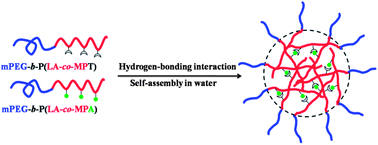Core-crosslinked amphiphilic biodegradable copolymer based on the complementary multiple hydrogen bonds of nucleobases: synthesis, self-assembly and in vitrodrug delivery†
Abstract
Nucleobases (

* Corresponding authors
a
State Key Laboratory of Polymer Physics and Chemistry, Changchun Institute of Applied Chemistry, Chinese Academy of Sciences, Changchun, P. R. China
E-mail:
yb huang@ciac.jl.cn
Fax: +86-431-85262769
Tel: +86-431-85262769
b Graduate School of Chinese Academy of Sciences, Beijing, P. R. China
c
The Cardiology Department of China–Japan Union Hospital of Jilin University, No. 126 Xiantai Str., Changchun 130033, P. R. China
E-mail:
mengfb@jlu.edu.cn
Fax: +86-13159757035
Tel: +86-13159757035
Nucleobases (

 Please wait while we load your content...
Something went wrong. Try again?
Please wait while we load your content...
Something went wrong. Try again?
H. Kuang, S. Wu, F. Meng, Z. Xie, X. Jing and Y. Huang, J. Mater. Chem., 2012, 22, 24832 DOI: 10.1039/C2JM34852G
To request permission to reproduce material from this article, please go to the Copyright Clearance Center request page.
If you are an author contributing to an RSC publication, you do not need to request permission provided correct acknowledgement is given.
If you are the author of this article, you do not need to request permission to reproduce figures and diagrams provided correct acknowledgement is given. If you want to reproduce the whole article in a third-party publication (excluding your thesis/dissertation for which permission is not required) please go to the Copyright Clearance Center request page.
Read more about how to correctly acknowledge RSC content.
 Fetching data from CrossRef.
Fetching data from CrossRef.
This may take some time to load.
Loading related content
